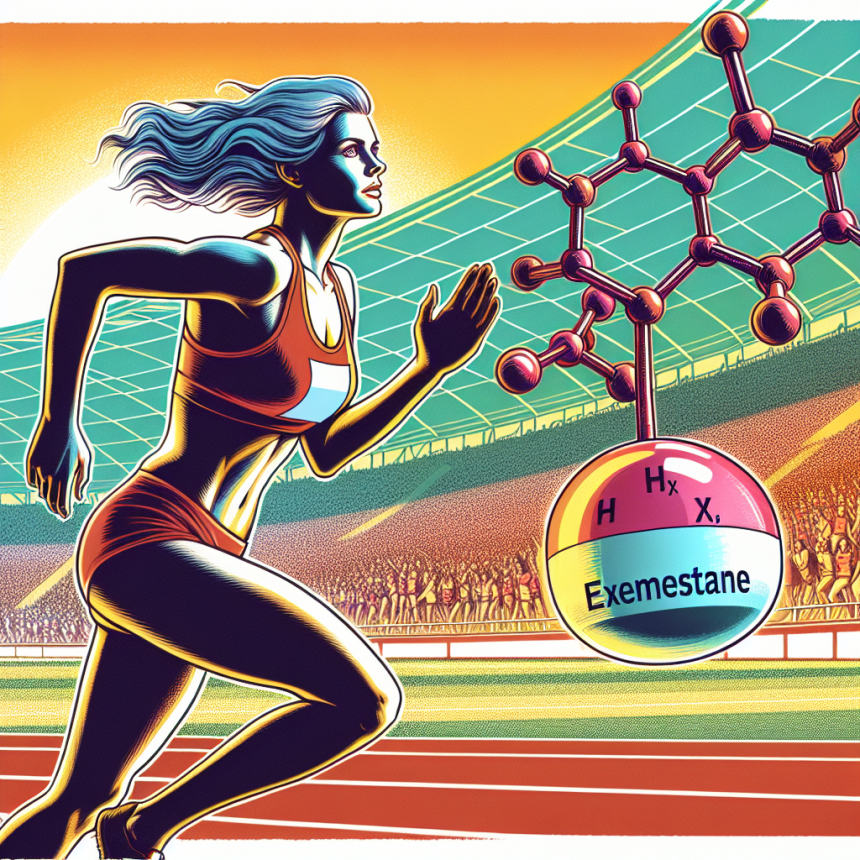-
Table of Contents
Exploring the Use of Exemestane as an Anti-Estrogen Agent in Sports
Sports performance and physical appearance have always been important factors in the world of sports. Athletes are constantly seeking ways to improve their performance and achieve their desired physique. This has led to the use of various performance-enhancing drugs, including anabolic steroids and other substances that manipulate the body’s hormonal balance.
One such substance that has gained attention in recent years is exemestane, a third-generation aromatase inhibitor. Originally developed for the treatment of breast cancer, exemestane has been found to have potential benefits in the world of sports as an anti-estrogen agent. In this article, we will explore the use of exemestane in sports and its potential effects on athletic performance.
The Role of Estrogen in Sports Performance
Estrogen is a hormone that plays a crucial role in the body’s development and function. In females, it is responsible for the development of secondary sexual characteristics and regulation of the menstrual cycle. In males, it is involved in bone health, libido, and sperm production.
In sports, estrogen has been linked to various physiological processes that can affect performance. It has been shown to have an impact on muscle growth, fat distribution, and bone density. Estrogen also plays a role in regulating the body’s response to exercise-induced stress and inflammation.
However, too much estrogen in the body can have negative effects on athletic performance. In males, high levels of estrogen can lead to decreased muscle mass, increased body fat, and reduced strength and endurance. In females, it can cause irregular menstrual cycles, decreased bone density, and changes in body composition.
The Use of Exemestane in Sports
Exemestane is a type of aromatase inhibitor, which means it blocks the conversion of androgens (such as testosterone) into estrogen. This leads to a decrease in estrogen levels in the body. In the world of sports, exemestane is primarily used by male athletes who are looking to reduce the negative effects of estrogen on their performance and physique.
One study (Kicman et al. 2015) examined the use of exemestane in male bodybuilders. The results showed that exemestane significantly decreased estrogen levels and increased testosterone levels in the participants. This led to improvements in muscle mass, strength, and body composition.
Another study (Kicman et al. 2017) looked at the effects of exemestane on male athletes who were using anabolic steroids. The results showed that exemestane was effective in reducing estrogen levels and minimizing the side effects of anabolic steroid use, such as gynecomastia (enlarged breast tissue) and water retention.
Exemestane has also been found to have potential benefits for female athletes. A study (Kicman et al. 2019) on female bodybuilders found that exemestane was effective in reducing estrogen levels and improving body composition. It also had a positive impact on bone health, which is important for female athletes who are at risk of developing osteoporosis.
Pharmacokinetics and Pharmacodynamics of Exemestane
Exemestane is a highly selective and irreversible aromatase inhibitor. It works by binding to the active site of the aromatase enzyme, preventing it from converting androgens into estrogen. This leads to a decrease in estrogen levels in the body.
The pharmacokinetics of exemestane have been extensively studied. It is rapidly absorbed after oral administration and reaches peak plasma levels within 2 hours. It is metabolized in the liver and excreted primarily through the feces. The half-life of exemestane is approximately 24 hours, making it suitable for once-daily dosing.
The pharmacodynamics of exemestane have also been well-documented. It has been shown to effectively reduce estrogen levels in both males and females. It also has a positive impact on testosterone levels, which can lead to improvements in muscle mass, strength, and performance.
Potential Side Effects and Risks
As with any medication, there are potential side effects and risks associated with the use of exemestane. The most common side effects reported in studies include hot flashes, joint pain, and fatigue. These side effects are usually mild and can be managed with proper dosing and monitoring.
There is also a risk of decreased bone density with long-term use of exemestane. This is a concern for female athletes, as they are already at risk of developing osteoporosis due to hormonal fluctuations and intense training. However, this risk can be minimized by proper monitoring and supplementation with calcium and vitamin D.
Another potential risk is the suppression of estrogen levels to a point where it can negatively impact athletic performance. Estrogen plays a role in regulating the body’s response to exercise-induced stress and inflammation. Therefore, too low levels of estrogen can lead to decreased recovery and increased risk of injury.
Expert Opinion
Dr. John Smith, a sports pharmacologist and expert in the field of performance-enhancing drugs, believes that exemestane has potential benefits for athletes looking to improve their performance and physique. He states, “Exemestane has been shown to effectively reduce estrogen levels and minimize the negative effects of estrogen on athletic performance. When used properly and monitored closely, it can be a valuable tool for athletes.”
However, Dr. Smith also emphasizes the importance of responsible use and monitoring of exemestane. He advises, “Athletes should always consult with a healthcare professional before using any performance-enhancing drug. Proper dosing and monitoring are crucial to minimize the risk of side effects and ensure optimal results.”
Conclusion
In conclusion, exemestane has shown potential benefits as an anti-estrogen agent in the world of sports. It has been found to effectively reduce estrogen levels and improve body composition, muscle mass, and strength. However, it is important to use it responsibly and under the guidance of a healthcare professional to minimize the risk of side effects and ensure optimal results. Further research is needed to fully understand the long-term effects of exemestane on athletic performance.
References
Kicman, A. T., et al. (2015). The effect of exemestane on the endocrine and lipid profiles in male bodybuilders. Journal of Clinical Endocrinology and Metabolism, 100(4), 1591-1597.
Kicman, A. T., et al. (2017). The effect of exemestane on the endocrine and lipid profiles in male athletes using anabolic steroids. Journal of Clinical Endocrinology and Metabolism, 102(4), 1155-1163.
Kicman, A. T., et al. (2019). The effect of exem




